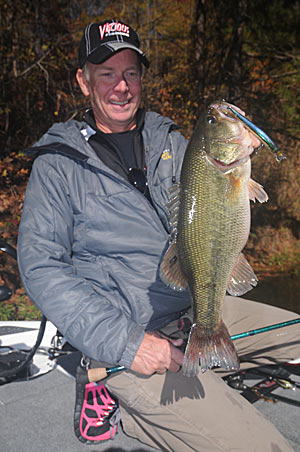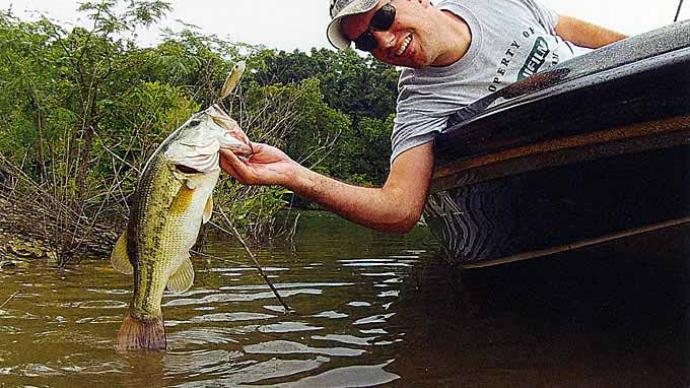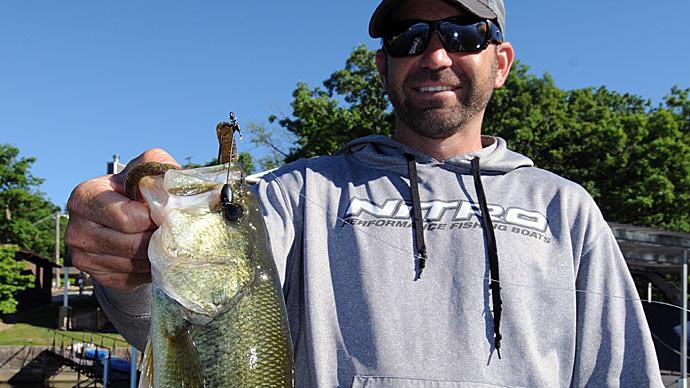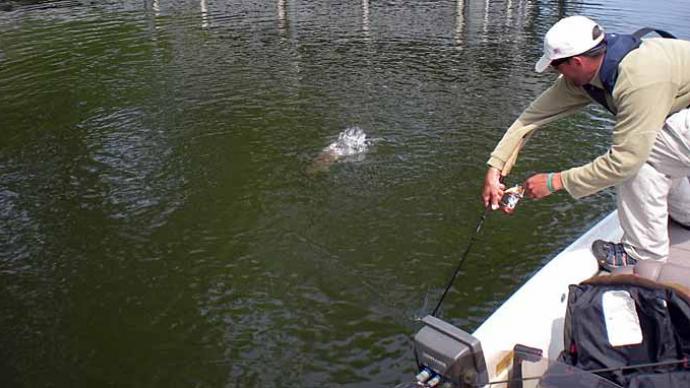
The weather is changing in the Northwest, marking the start of the rainy season. Reservoirs should be at their lowest levels now, ready to collect all that rain. This low-water situation could very well lead to excellent early winter bass fishing for those willing to put in a little extra effort. Due to the low water conditions, some ramps may not be useable, but there is almost always an old roadbed to launch from. I have a big 520 Ranger, and launching from old road beds is not a problem. A low-water condition tends to concentrate the fish and fishing can be fast and furious as the bass feed heavily in preparation for winter. Most of the reservoirs in the Pacific Northwest will see these conditions this year.
I use several techniques this time of the year. One method that works well to use a wide wobble crankbait fished very slowly. The key is to only retrieve fast enough to make the crankbait wobble, combined with frequent pauses along the way. Many strikes will come as you start the retrieve after pausing. A suspending crankbait works best.
Both crawdad and baitfish patterns can be excellent this time of the year. One local reservoir I fish has a good crappie population and the bass gorge themselves on small crappies in preparation for winter. On this reservoir, white crankbaits seem to work the best. I use a 7-foot G.Loomis crankin' series rod with 10-pound-test line and the light rods allow me to crank all day without wearing myself out.
In late November, the bass migrate to vertical areas of the lake. Creek channels and rock bluff areas can both hold large concentrations of bass. I will switch to a 1/2-ounce dark-colored jig and plastic trailer and fish these areas very slowly. If these two techniques fail to produce I will try a splitshot rig with a 4-inch Berkley power worm in the same areas.
The natural lakes in the Pacific Northwest tend to hold water at more normal levels and will fish differently than reservoirs; the bass do not concentrate as much and tend to follow normal winter patterns. Late fall fishing can be very good on these lakes as well, and access is better. Slow rolling a big single blade spinnerbait off the weed edge in deep water works well for me late in the year. I like the 1/2-ounce single Colorado blade spinnerbait for this method and work it along the weed edge in 14 to 16 feet of water. It is a good big bass technique in the late fall. The bass tend to school up along the weed edges and if I catch one on the spinnerbait, I will work the area thoroughly with jigs and split-shot rigs. A dropshot rig can also be effective worked vertically around old train trestles and wood dock piling.
One other option for late fall/early winter is fishing smallmouths on the Columbia River. Smallmouths will move out of the current as flows increase and the water cools. Many will migrate to slack water areas such as backwaters and sloughs. It is possible to locate large schools of smallmouths in these places and they will stay all winter. Any large current break can also hold fish on the down stream or slack water side. I like to fish with a 1/2-ounce brown jig and twin tail plastic trailer in the same color when the water first cools. I fish it slowly with an exposed hook on the jig. Many times you will not feel the bite and the exposed hook will catch in the mouth of the bass as they try to expel the jig giving you Lime to react and set the hook. This is still good through November depending on the weather.
After the water turns cold I switch to marabou jigs in black or brown. The small 1/8-ounce jigs can be deadly in cold water fished very slowly out of the current in back water areas. Small marabou jigs have the subtle action that can produce when almost nothing else will. I haven't tried it yet, but I wonder how a couple of marabou jigs rigged dropshot style would work. It would keep the small jigs suspended where the action would really be visible to the bass.
The other standby method for cold-water smallmouth is splitshot rigging small plastic baits. A light splitshot will get more bites and less hang-ups. Worms, grubs, and reapers all have days when they are very effective.
The low-water conditions this year will bring some excellent bass fishing opportunities. Help others understand the importance of catch and release because the bass will be vulnerable this fall and damage to populations could occur, especially in some of our smaller reservoirs.
Just as a reminder, fishing during the winter season can be very enjoyable, but it also increases many dangers. Hypothermia is deadly and in the waters of the Pacific Northwest, can set in rapidly. Make sure to always wear a life vest and keep spare clothes on the boat in case you do fall in.
Also, putting a swim ladder on the back of your boat might just save your life someday. When hypothermia sets in many times controlling our muscles becomes difficult and climbing back into your boat can quickly become impossible. A swim ladder can make it much easier to get back in the boat quickly and safely.
Go out there and have fun, this fall and winter; there is no reason to sit at home suffering from cabin fever; there is still plenty of great fishing to enjoy. So get out there and fish! And we'll see you on the water.
Reprinted with permission from Bass West Magazine




